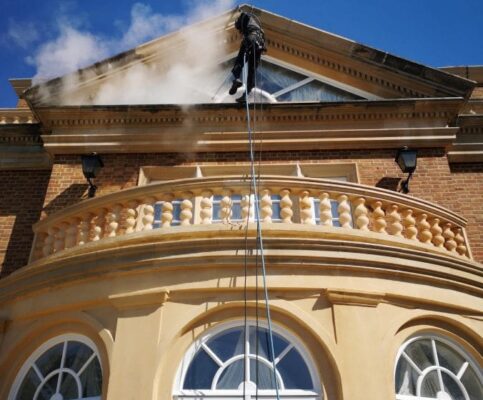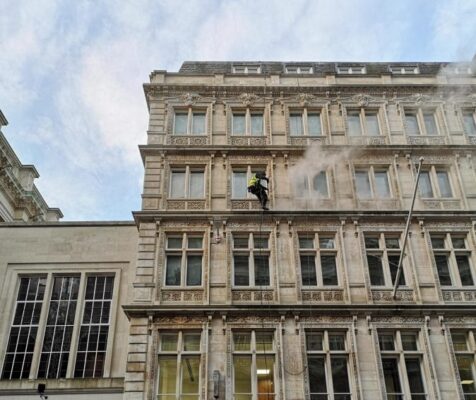View More SErvices Contact Us
Facade Cleaning in Docklands
Cleaning building facades from top to bottom, no matter how tall your building.
Natural stone facade cleaning in Docklands can be accessed and cleaned efficiently and effectively by using rope access methods. Using this method, the need for local authority permits is totally eradicated, allowing works to proceed immediately. Using professional stone cleaning equipment we can roll back the years to make your building look like new.
Brick cleaning
Brick buildings become dirty as much as any other building. We will not only clean away the dirt and grime, we can revitalise the colour. Using a range of bio-degradable chemicals, we can restore the colour of red or yellow bricks.
Contact UsGlass facade cleaning in Docklands
Glass facade cleaning in Docklands takes place by abseilers using traditional window cleaning tools. External windows, internal atriums, after builders cleaning or regular maintenance cleans, our abseilers are experienced in all manner of glass cleaning.
Contact UsAluminium cladding cleaning
Aluminium cladding in Docklands can become extremely dirty over time. Warehouses that have many lorries coming and going will become soiled with traffic film. Using our steam cleaning systems, this grime is washed away leaving a lasting first impression for your visitors.
Contact UsOur services
Rope Access Facade Cleaning Services for Docklands And Surrounding Counties

Residential property Stone Facade Cleaning
Façade cleaning at this residential property in Docklands, which was not of any great height but, had no access for other forms of access equipment. Abseiling was the solution and the results were outstanding.

Stone Steam Cleaning in London
This beautiful natural stone building was looking tired from the day to day London traffic. Rope access was seen as the most cost-effective method of access.

Concrete Facade Cleaning in Docklands
This car park in Essex was filthy. It hadn’t been cleaned, ever. As the access to three elevations was extremely tight, abseiling was the only method that could achieve the results.

Facade Cleaning in Bethnal Green
A new acquisition for our client needed a freshen up. Out of hours abseiling was the best way to clean this building in the heart of the City of London.
Brick colour restoration
Before colour restoration
This client requested a test patch before assigning us the job of cleaning their building. We carried this out with amazing results.
After colour restoration
These are the pictures of the test patch that we sent to the client. Her reaction was simply ‘WOW’. That’s the perfect response for us.
Torik Stone Cleaning System Features
150 degrees centigrade steam cleaning power
Provides a continues flow of superheated water to penetrate stone and deep clean, removing organic growth & ground in dirt.
We use Tensid (uk) Ltd
Providers of specialist cleaning equipment and specialist cleaning chemicals to professionals.
Get In Touch
Fill in the form below and we’ll be in touch within 24hrs of receiving your message.
Facts About Docklands
Docklands History
German bombing during the Second World War caused massive damage to the docks. With 380,000 tons of timber destroyed in the Surrey Docks in a single night. Nonetheless, following post-war rebuilding, they experienced a resurgence of prosperity in the 1950s. The end came suddenly, between approximately 1960 and 1970, when the shipping industry adopted the newly invented container system of cargo transportation.
London’s docks were unable to accommodate the much larger vessels needed by containerization, and the shipping industry moved to deep-water ports such as Tilbury and Felixstowe. Between 1960 and 1980, all of London’s docks were closed, leaving around eight square miles (21 km²) of derelict land in East London.
General Info
London Docklands is the riverfront and former docks in London. It is located in inner east and southeast London, in the boroughs of Southwark, Tower Hamlets, Lewisham, Newham, and Greenwich. The docks were formerly part of the Port of London, at one time the world’s largest port. After the docks closed, the area had become derelict and poverty-ridden by the 1980s.
The name “London Docklands” was used for the first time in a government report on redevelopment plans in 1971 and has since been almost universally adopted. Redevelopment created wealth, but also led to some conflict between the new and old communities in the area.



